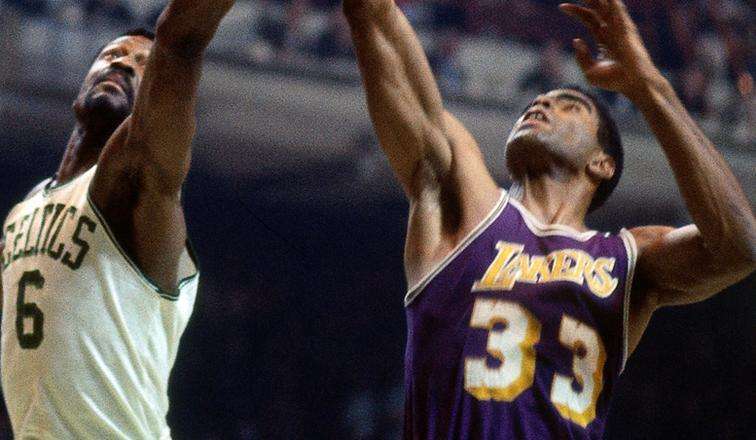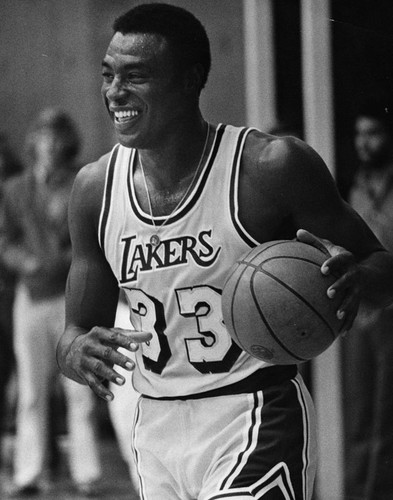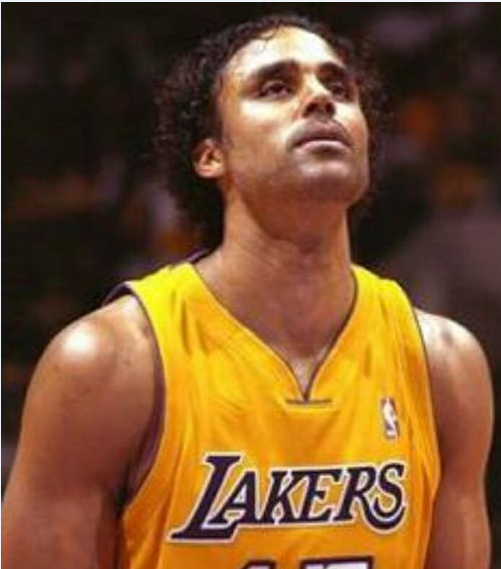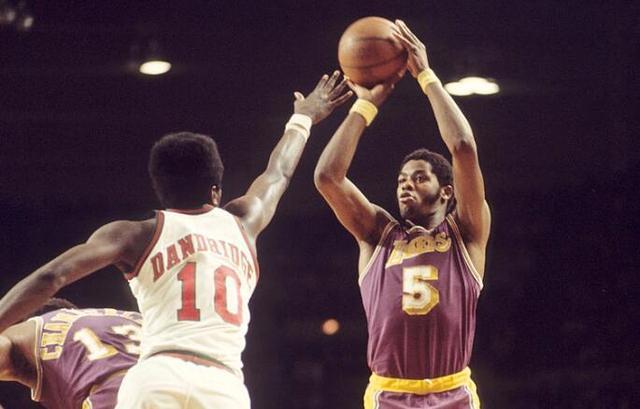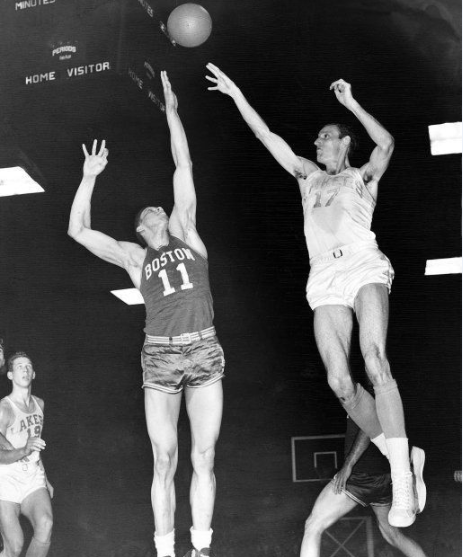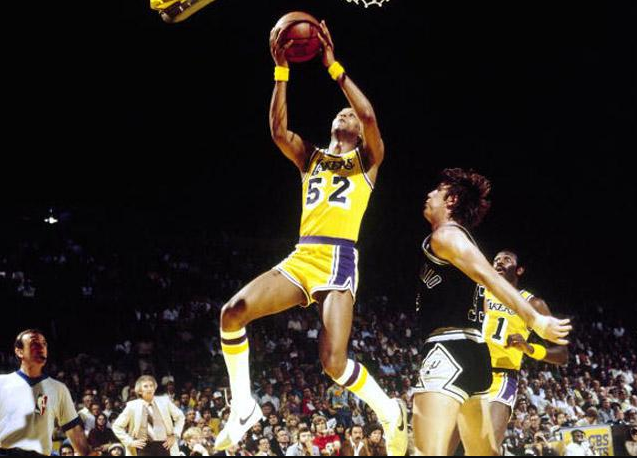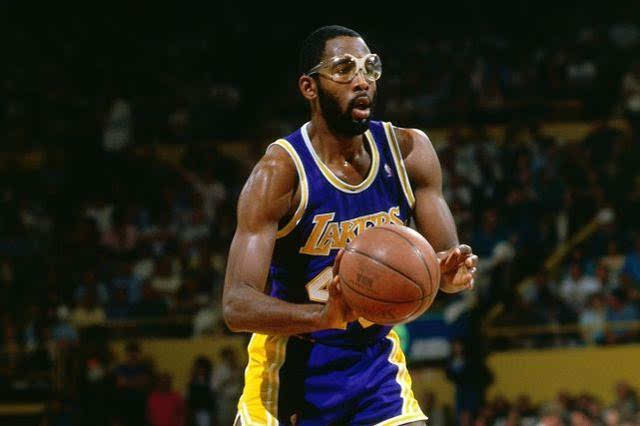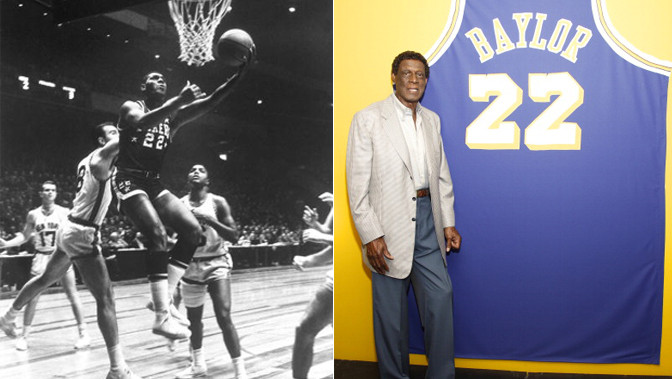【湖人国度】湖人历史10大小前锋排名 |
您所在的位置:网站首页 › 小前锋名人 › 【湖人国度】湖人历史10大小前锋排名 |
【湖人国度】湖人历史10大小前锋排名
|
德文·乔治—他值得我们的肯定,在湖人时期,他曾完成连续上场429场的成就,其中90%的时间作为替补登场,场均能拿到6分。 还有4名小前锋,不过他们要么是效力仅两个赛季,要么是上场不足150场,因此,不能出现在这份榜单里,但他们的场均得分都能上双,分别是:康尼尔·霍金斯(70年代初的球员,场均11分,6.3个篮板)、阿德里安·丹特利(70年代末的球员,场均18.3分,6.4个篮板)、塞德里克·塞巴洛斯(90年代的球员,场均20.9分,7.3个篮板)、格伦·莱斯(场均16.3分,在2000年随队夺冠)。 现在,我们开始倒数前10。
第10位:罗恩·阿泰斯特/慈善·世界和平/熊猫之友 慈世平是球迷的最爱,他风趣幽默、直言不讳。可以这么说,慈世平是那段时间里加盟湖人的最大牌的自由球员。 慈世平属于防守型的球员,身型强壮。在加盟湖人以前,他曾获得过最佳防守球员,并且入选了防守一阵,加盟湖人之后,防守虽有下滑,但还是可以最大程度的限制对手,并且效率极高。 慈世平在湖人时期的进攻效率已经比不上以前,在来到湖人的前7个赛季里,他场均至少能得到15.5分,04-05赛季,他在步行者拿到生涯最高的场均24.6分。 来到湖人的第一个赛季,慈世平的得分场均不到10分,但是他在10年季后赛的两次关键投篮会永远被湖人球迷铭记:西部决赛G5打太阳时抢到科比投丢的前场板后的压哨补篮绝杀,在总决赛抢七战中第四节的那个关键三分,帮助球队拿到了总冠军。 在2011年,阿泰斯特正式把名字改成了慈世平。他在2013年被湖人裁掉,但是一年之后,他又以一纸两年的合同回到了湖人。这次,他以老将的身份回归球队,虽然没有很多的上场时间,但是他更多起到的是带领新人成长的作用。总的来说,慈世平在湖人的的6个赛季中,场均能得到8.9分。
第9位:汤姆·霍金斯 “老鹰”霍金斯本来是埃尔金·贝勒的替补,在他6年(60年代)的湖人生涯中,他也成了贝勒的好友。不过他并没有为湖人连续效力6年,而是先打了3年,然后转去了辛辛那提皇家队打了四年,才又回到湖人。 霍金斯一直是替补席上一个稳定的火力点,场均得分在7.1到11.6之间,除去最后一个赛季,他的场均篮板在5.7到6.9之间,他的上场时间大概在20分钟左右。总的来说,场均数据是9分5.7个篮板。 霍金斯人缘很好,受人喜爱,退役了之后,他就一直留在了洛杉矶,先是在一家广播公司工作,后来去了道奇队工作了17年。 在他的湖人生涯中,球队曾3次在总决赛中输给了凯尔特人,数年之后,当湖人在1985年总决赛中击败凯尔特人时,霍金斯穿着他的湖人队服在家中庆祝胜利。
第8位:凯兹尔·拉塞尔 拉塞尔是NBA历史上一把著名的神经刀,手感火热时,无论从哪里出手,他几乎都百发百中。 其实一开始,拉塞尔是尼克斯在1966年选中的状元秀,虽然他的职业生涯和人们想象中的状元秀有所差距,但他依旧是尼克斯1970年冠军阵容中的重要一员。 后来拉塞尔被交易到了勇士队,打了3个赛季之后,他在1974赛季来到了湖人。然而,那几年是湖人历史上最落寞的时期之一了,拉塞尔本人也接近职业生涯的尾声。 不过拉塞尔在湖人时期的投篮很不错,不管是替补还是首发,他都是球队不可缺少的一部分。拉塞尔在200场湖人生涯中,场均14.5分,这几乎都是在外线投出来的,命中率也能达到47%。
第7位:里克·福克斯 福克斯是那种场上表现优于数据体现的球员。 在湖人的7个赛季中,他仅有一个赛季得分上双——那是他刚刚加盟湖人,首发出场全部比赛得到的数据,那一年,他的上场时间、命中率和抢断均是湖人生涯最高。 也许你会觉得,首个赛季结束以后,福克斯就开始走下坡路了,但实则不然。他是湖人21世纪初3连冠阵容中重要的一员,2000年,他作为格伦·莱斯的替补登场,之后两年,福克斯均是首发。 福克斯长相不错,这让人们很难将他的脸与他凶恶硬朗的球风结合起来。他是一个狡猾的防守者,每次防守都不遗余力、不留情面。所有的冠军球队都需要这样一位愿做脏活累活的人,福克斯在湖人扮演的就是这样的角色。他稳定而可靠,7年中,有4年打满了82场常规赛,1年打了77场。 福克斯是湖人队最好的射手之一,3分命中率也不错,场均8.7分。退役后,转向好莱坞发展。
第6位:吉姆·麦克米兰 读过这个系列文章的人可能会知道,总有那么几位湖人渐渐被世人所遗忘,这些年里,由于这样或那样原因,他们淡出了人们的视野。吉姆·麦克米兰就是这样的一位球员。 麦克米兰在1970年第一轮被选中,然而只为球队打了3年。但是,仅凭着后两年场均近19分的优秀表现,也足够让他出现在这份榜单里了。 1971-72赛季,贝勒在打了9场比赛之后就伤退了,麦克米兰进入首发,不管是不是巧合,在那之后,湖人队焕然一新,战绩一飞冲天。麦克米兰首发后的第二场比赛湖人就取得了胜利,那场比赛还有一个更独特的身份——那是湖人33连胜的第一场胜利。直到现在,北美职业联盟还没有任何一支球队能打破这一连胜纪录。 那个赛季,湖人拿下了总冠军,那是他们搬到洛杉矶之后获得的第一座总冠军奖杯。麦克米兰场均得分排名球队第三,在他之前是名人堂球员古德里奇和韦斯特。之后的一年,虽然湖人在总决赛中输给了尼克斯,但是麦克米兰的表现依然抢眼。 1972-73赛季,张伯伦突然宣布退役,湖人为了填补中锋位置的空缺,用麦克米兰交易来了布法罗勇敢者队的埃尔摩尔·史密斯。 对于麦克米兰来讲,他的湖人生涯短暂而璀璨。总的来看,场均15.3分(那时候NBA还没有3分线),5.4个篮板。同时,麦克米兰还以他的底角投篮著称。
第5位:迈克尔·库珀 库珀十分全能,可以打多个位置,他的队友贾巴尔就因为他的适应能力为他取了个绰号,叫“瑞士军刀”。库珀其实在得分后卫的位置上也打过很长时间,因此,你们在那份榜单上也会看到他的名字。 库珀的出色防守能力广为人知,只要不是中锋,对方的箭头人物就是由他来防守。库珀身高6尺6寸,体重170磅,比起伯德,他要矮3寸、轻50磅,不过伯德说过,没有人能像库珀一样给与他如此强硬的防守。 起初,库珀的得分手段比较单一。大多都是和魔术师之间的空接扣篮、捡漏上篮和垃圾时间的得分,不过随着时间的推移,他的武器库逐渐丰富。 最重要的,库珀渴望胜利,他是那种任何冠军球队都想要拥有的球员,他能为球队来带精神上的鼓舞,作为80年代湖人Showtime时代的缔造者之一,他随队获得了5座总冠军奖杯。 库珀90%的比赛都是作为替补登场的,不过纵观他在湖人队的所有比赛,出场时间基本都过半。在职业生涯中,他场均能得到8.9分,但他对球队的贡献远大于这个数字。
第4位:吉姆·波拉德 这真的是一位大隐于市的人物了,你们可能不熟悉他,但波拉德是那支5获总冠军的明尼阿波利斯湖人队的中流砥柱了。 已经很少有人看过波拉德的比赛了,但是他打球真的很棒,就像他的队友乔治·麦肯一样,波拉德也可以算是50年代的超级巨星。 波拉德身高6尺4寸,运动能力极强,他有一个绰号,叫“袋鼠小子”,就是因为他的弹跳太过出众——他是最早在篮筐上进行高空作业的那批人之一。同时,波拉德的速度也是快的惊人,他常常能在阵地战转换进攻时带领球队打出快攻冲击波。 波拉德的控球技术也很好,他很擅长运球突破,篮下终结能力也很强。更可怕的是,他的防守能力也是数一数二的。 职业生涯中,波拉德四次入选全明星(虽然那时候联盟只有10支球队),场均得分稳定在10.8分到15.5分之间,若是把样本缩小到在湖人队的那7年,数据就变成了场均13.2分7.8个篮板。
第3位:贾马尔·威尔克斯 威尔克斯绰号“丝绸”,仅仅看名字,我们就知道他在场上是多么如鱼得水。在进入联盟前,他效力于UCLA,闪耀大学联盟。进入联盟之后,他先在勇士队效力了3年,然后才在1977年以自由球员的身份加盟湖人,和贾巴尔、丹特利和新秀控卫诺姆·尼克森成为了队友。 之后的8个赛季中,威尔克斯就是“稳定”的代名词,其中的7年,他的场均得分上双。威尔克斯的投篮姿势有一点怪异,他出手前会把球收到脑后,但这并不影响他的命中率。前湖人传奇播音员奇克·赫恩称他的投篮为“20尺的上篮”。 威尔克斯身高6尺6,体重190磅,是一位快攻好手,他人也很不错,虽然代表湖人两次入选全明星,但他毫不在意人们将赞赏都给予他的队友贾巴尔和魔术师约翰逊。 威尔克斯生涯最佳比赛应该是1980年总决赛对阵76人的第6场。对于那场比赛,球迷的记忆可能是贾巴尔由于脚踝扭伤而缺席,魔术师顶上中锋的位置砍下了42分15个篮板的惊人数据。但在那场比赛,威尔克斯的表现也很惊艳,他拿下了职业生涯最高的37分,同时还有10个篮板,在球队最需要他的时候挺身而出。 在1980-82赛季,威尔克斯连续3个赛季场均得分上20,其中的两个赛季,湖人拿到了总冠军。之后的84-85赛季,威尔克斯遭遇了伤病,限制了他的上场时间。最终,威尔克斯因此终结了职业生涯,他的最后一个赛季是在快船队度过的。 威尔克斯的场均得分和总得分均排在湖人队史第10位,分别是18.4分和10601分(总得分这一项领先后一名很多)。他的52号球衣也已退役,悬挂在球馆上空。
第2位:詹姆斯•沃西 听到詹姆斯•沃西的名字,你很难不联想到“大心脏”,你可能会觉得很奇怪,为什么在其他球队都毫无疑问能够排到第一的沃西会来到第二位。 沃西是1983年的状元秀,这个签位是湖人3年之前和骑士交易得到的,付出的代价是:一个还算不错,但绝对称不上优秀的前场球员。结果,这桩交易成了湖人最好的几桩交易之一。 沃西的菜鸟赛季和最后一年,他打的都是替补,此外的期间10年,他基本上都是首发出场,场均得分均能上双,而且7次入选全明星。 作为Showtime时代的一员,沃西代替了威尔克斯出任球队的首发小前锋,对内的先发球员还包括贾巴尔、魔术师、库珀和拜伦·斯科特,这一阵容可以称得上是湖人队史最佳了,就算是放眼NBA,也鲜有对手。沃西是一名出色的快攻终结者,在阵地进攻中,他的敏捷性可以让他跟上几乎任何人的持球突破。 在沃西效力湖人期间,球队6进总决赛(虽然他曾在1983年因为腿伤缺席了一次),三次夺得总冠军。就像威尔克斯样,沃西也是一位大场面球员,聚光灯越是闪亮,他的发挥越是出色。在1988年的总决赛抢七大战中,他拿下了他生涯唯一一次三双——36分,16个篮板和10个助攻,也助他拿下了总决赛MVP。 当然,他的另外两个冠军也是十分具有意义的,因为它们都是面对凯尔特人时拿下的,沃西也在这两次总决赛之旅中扮演了十分重要的角色,他是极少几位季后赛数据优于常规赛的球员。 整个职业生涯,沃西场均17.6分,5.1个篮板,而在季后赛,这个数据来到了21.6分(湖人队史第6),5.2个篮板。他的常规赛总得分在球队历史上能排到第6(出场次数第4),季后赛的总得分位列第7(出场次数第8)。 当然了,沃西的球衣现在也已经高高悬挂在斯台普斯的上空。
第1位:埃尔金•贝勒 即使是拿沃西这种大神来比较,埃尔金·贝勒依然是当之无愧的湖人队史第一小前锋。 有一种说法,贝勒是最被忽视的巨星。年轻的球迷们,你们没能有机会看到他的比赛,真的是错过了传奇的表演。事实上,那个时代的球员都是如此,他们的比赛很少有电视转播,现在仅存有很少的影像资料,来向我们展示他们的表演。 贝勒善于空中作业,动作眼花缭乱,没人能看清楚他究竟干了些什么。他似乎有一种超能力,比你先起跳,比你晚落地,在空中做出一些匪夷所思的动作来。 贝勒可以以任何方式出手投篮,你很难想象会有别的球员在那样的角度出手。从康尼·霍金斯到J博士,从迈克尔·乔丹到科比·布莱恩特,这些传奇无一例外的承认,他们的出手方式和贝勒有几分相似。 贝勒生涯的前两个赛季赛在明尼阿波利斯度过,之后才在1960年随球队来到了洛杉矶。他的菜鸟赛季便场均24.9分,之后6个赛季,场均得分就再也没有下过25,60-63这三个赛季,场均得分更是突破了30。不过随后,贝勒遭遇了膝伤,差点断送了他的职业生涯,场均得分迅速滑落到了16.6分。不过仅仅消沉了一个赛季,之后的四年里,数据又回到了24分以上。 贝勒所在的那支湖人对在60年代曾6次在总决赛中面对凯尔特人,每次都是铩羽而归。6次中有3次,球队打到了抢七,更有一次把抢七大战拖入了加时。不过遗憾的是,贝勒和韦斯特这伟大的二人组合在面对波士顿的名人堂阵容时(比尔·拉塞尔、鲍勃·库西、汤姆·海因索恩、萨姆·琼斯、约翰·哈夫利切克和一众板凳匪徒),没能拿下任何一场总决赛。 在1962年,贝勒创下了一个至今未破的总决赛记录——他面对凯尔特人砍下了61分,在常规赛时,他曾在尼克斯头上拿下过71分,在科比的81分惊艳世界之前,这一直是湖人的常规赛得分记录。 总的来说,在贝勒14年的职业生涯中,场均可以拿到27.4分,湖人队史最佳。在总得分榜上,他以23149分位列第四,出场846次,位列第十。尽管他只有6尺5,他的场均篮板数却和乔治·麦肯持平,达到了13.5个。季后赛时,贝勒的数据为场均27分(队史第2)12.9个篮板(队史第3),总得分3623,排在第5。 当然了,贝勒的球衣高悬在球馆上空。今年的早些时候,球馆外面还建起了他的雕像,埃尔金·贝勒,这位11次入选全明星的球员,算得上当之无愧的NBA历史最佳之一。 下面是按出场时间对他们的排名:波拉德-贝勒-霍金斯-麦克米兰-拉塞尔-威尔克斯-库珀-沃西-福克斯-慈世平 原文: Los Angeles Lakers: 10 greatest small forwards in Lakers history by Ed Schrenzel This is the third installment in a multi-part series ranking the best Los Angeles Lakers at each position. The Los Angeles Lakers are one of the greatest franchises in the NBA. Here, we are continuing our series breaking down the greatest Lakers to ever play position by position. As a reminder, this is the criteria for a player to be included on the list: • Played a minimum of 3 seasons with the Lakers. Longevity with the team is a factor. • Only his performance with the Lakers counts • Can be rated at more than one position • Minneapolis Laker players are included Previous installments featured rankings of centers and power forwards. This time we rate the top small forwards, which will include a mixture of steady, consistent longer-term players with a couple who shined brightly for a shorter period of time. There was also a conscious attempt not to favor more recent players who are better remembered than some of the oldies-but-goodies. Honorable Mention: • Keith Erickson– The former UCLA Bruin played five seasons for the Lakers in the late 60’s and early 70’s, averaging 9.2 points. He was steady and solid, a valuable reserve. Years later, he became a broadcast partner to the legendary Chick Hearn for eight years. • Mike McGee– He was a reserve on the Showtime Lakers, including two title teams. He didn’t play big minutes, but he made the most of the time he was given, averaging 8.2 PPG over five seasons. • Luke Walton– He was never a big scorer (just under 5 PPG), averaging double figures only once in his nine-year Lakers playing career. But he was an excellent passer and had a good feel for the game. And while injured, he studied coaching under Phil Jackson. • Devean George– He deserves some recognition for logging 429 games in a Lakers uniform, about 90 percent of them as a reserve. He scored 6 PPG. • Four different small forwards played only two seasons and fewer than 150 games each for the Lakers, not enough to qualify for the top 10. But all were double-figure contributors: Connie Hawkins (11 PPG and 6.3 RPG, the early 70’s), Adrian Dantley (18.3 and 6.4, late 70’s), Cedric Ceballos (20.9 and 7.3, 90’s) and Glen Rice (16.3 points, including the 2000 title team). Now on with the top 10 countdown. No. 10: Ron Artest/Metta World Peace A fan favorite mostly because of his quirky personality and willingness to speak his mind, Artest was the last reasonably big name free agent to sign with the Lakers. An exceptionally strong man, he was particularly known for his outstanding defense. Before joining the Lakers he was a former Defensive Player of the Year and was chosen to five All-NBA Defensive Teams. His defense may not have quite reached that level with LA, but he still found ways to be effective and to frustrate opponents. Also, he was no longer the offensive force that he once had been. In his last seven seasons before coming to the Lakers he had averaged 15.5 points or better, including a career-high 24.6 in 2004-05 with Indiana. In his first four seasons with the Lakers, Ron averaged just under 10 PPG. But he will always be remembered for two big shots in his first season during the 2010 playoffs: a buzzer-beating follow-up of a Kobe Bryant miss that won Game 5 against Phoenix, and a huge 3-pointer in the final minutes of Game 7 of the Finals to secure a title win over the Celtics. In 2011, Artest legally changed his name to Metta World Peace. He was waived by the Lakers in 2013 but joined them for two more seasons a year later. This time around, he was mostly a veteran presence for the younger players and didn’t get much court time. Overall in six Lakers seasons, he averaged 8.9 PPG. No. 9: Tommy Hawkins The Hawk was primarily a backup and friend to the great Elgin Baylor during his six Laker seasons in the 1960’s. He played for them for his first three seasons, then was traded to the Cincinnati Royals, where he played four years. Then the Lakers re-purchased his contract, and he played his final three seasons in L.A. Tommy was a consistent presence off the bench throughout his Laker career. His scoring average varied only slightly, ranging from 7.1 to 11.6 points per game. In five of his six years, he averaged between 5.7 and 6.9 rebounds. He generally played about half the game, and overall averaged 9.0 and 5.7. Hawkins was a very likable man with a gregarious personality and became a fixture in Los Angeles when his playing days ended. He first worked as a local broadcaster and then went on to work for the Dodgers for 17 years. In his Lakers career, the team lost in the Finals three times to the Celtics. Years later, when LA finally beat Boston to win the title in 1985, the Hawk was shown celebrating at his home while wearing his old Lakers jersey. No. 8: Cazzie Russell “Jazzy Cazzie” was one of the NBA’s best all-time streak shooters. When he got hot, it seemed like he couldn’t miss, no matter where he shot from. He was originally the top pick of the 1966 pick by the Knicks. Although he didn’t have the type of career you’d expect from the No. 1 pick, he still was a major weapon for New York and was a valued member of their 1970 title team. After starring for Golden State for three years, he was traded to the Lakers, where he played another three seasons, all in the mid-1970’s. Unfortunately, that was a time that the team started to fall on leaner times, and Russell was nearing the end of his 12-year NBA career. But Cazzie brought his jump shot with him to L.A., and was a big contributor, both as a starter and reserve. He averaged 14.5 points in his roughly 200-game Laker stint. And even more impressively for a player who mostly shot from the outside, he made over 47 percent of his field goal attempts, the highest of his career. No. 7: Rick Fox Foxy was one of those players whose value to his team exceeds his rather modest statistics. In 7 seasons with the Lakers, he averaged double figures in points only once. That occurred during his initial year with the club when he started all 82 games and also established his Laker highs in minutes played, shooting percentage and steals. It might appear that his career went downhill from there, but that assumption would be incorrect. He was a major contributor to the Lakers “three-peat” title run from 2000-02, the first year as a reserve backing up Rice, the next two seasons as a starter. Fox, who was known for his good looks, was also somewhat paradoxically a scrappy, hard-nosed defender, a no-nonsense player who gave full effort all the time. Every title team needs a player who doesn’t mind doing the dirty work, and Rick filled that role with the Lakers. He was consistent and reliable, and played in all 82 games 4 times in 7 seasons, and in 77 games another year. But Fox also was one of the team’s better 3-point shooters and averaged a respectable 8.7 points for LA before retiring to test the Hollywood waters. No. 6: Jim McMillian Readers of this series know that there seem to be several “forgotten” Lakers, players who for one reason or another have not been well-remembered through the years. Jimmy Mac was one of those guys. He was a first-round draft pick in 1970 and only played three seasons with the club. But the final two of his years, when he averaged close to 19 points per game each season, were enough to earn him this ranking. After Baylor was forced to retire 9 games into the 1971-72 season, McMillian stepped into the starting lineup. And, coincidently or not, the Lakers took off like a rocket. In the very next game, they won the first of what turned out to be 33 straight games, which remains the longest winning streak in any of the four major North American pro sports leagues. The Lakers went on that season to capture its first title in Los Angeles. Jimmy was the third-leading scorer on the team behind future Hall of Famers Gail Goodrich and Jerry West. He repeated that performance the following season when the team lost in the Finals to the Knicks. When Wilt Chamberlain abruptly retired after that 1972-73 season, the Lakers were in dire need of a center. So they traded McMillian to Buffalo for Elmore Smith. His Lakers career was short but quite sweet. Overall, he averaged 15.3 points (in the days before the 3-point shot) and 5.4 rebounds. Mac was especially well known for his almost automatic baseline jumper. No. 5: Michael Cooper Coop was an extremely versatile multi-position player. Teammate Kareem Abdul-Jabbar labeled him a “Swiss army knife” because of his adaptability. He played more shooting guard than small forward and will be ranked there as well. Michael was known first and foremost for his fearless defense, almost always guarding the opponent’s best-scoring non-center. At 6-6, 170, he gave up 3 inches and 50 pounds to Larry Bird, but Larry Legend said nobody guarded him tougher than Cooper did. In his first few years, his offensive range was rather limited, consisting mostly of “Coop-a-Loop” dunks, an early version of the lob pass, and other lay-ins or garbage baskets. But as time went on and he became quite a respectable shooter. Above all, Coop was a winner, one of those guys who does whatever is necessary that every championship team must have. He was an enormously important member of the 1980’s Showtime Lakers, helping them win 5 titles. He came off the bench in 90% of his games, but in nearly every one of his 12 seasons, all with the Lakers, he played more than half the game. For his career he averaged just 8.9 points, but his value to the team transcended his scoring. No. 4: Jim Pollard A true oldie but goodie, he was a mainstay on all 5 Minneapolis Laker championship teams. Few readers have ever seen him play, but he apparently was quite talented. Like his teammate, dominating center George Mikan, Pollard was widely considered to be one of the best players of the early 1950’s. A tremendous 6-foot-4 athlete who was nicknamed “The Kangaroo Kid” for his outlandish jumping ability, Jim was one of the first players to play above the rim. He was also one of the fastest players in the league and often led the charge downcourt to become the finisher on the fast-break. Pollard was an excellent ball-handler who was adept at beating his opponent off the dribble while having the agility to finish at the hoop. Plus he was known as a top defender. He was a four-time All-Star, albeit in a 10-team league. He consistently scored between 10.8 and 15.5 PPG, and over his 7-season Lakers career he averaged 13.2 points and 7.8 rebounds per game. No. 3: Jamaal Wilkes Nicknamed “Silk”, because of how smooth he looked on the court, the former UCLA star played his first 3 seasons with the Warriors before signing as a free agent in 1977 with the Lakers, joining Kareem, Dantley and rookie point guard Norm Nixon. Over the next 8 seasons, he was a model of consistency, averaging double figures in points for the first 7 years. Silk was known for the weird-looking corkscrew windup on his jumper when he brought the ball back behind his head before releasing it. But that shot was so reliable that famed Lakers announcer Chick Hearn labeled it the “20-foot layup”. The slender (6-6, 190) Wilkes was also an excellent finisher on the fast break. And he was also a great teammate. Although he made the All-Star team twice for the Lakers, his ego was quite content to allow most of the accolades to fall on his more famous superstar teammates like Abdul-Jabbar and later also Magic Johnson. Probably the best game of his career occurred in Game 6 of the NBA Finals. Fans may recall that was the game which Kareem was forced to miss with a sprained ankle, and Magic stepped in to jump center and have a fabulous performance with 42 points and 15 rebounds. But Wilkes was also outstanding, scoring a career-high 37 points and grabbing 10 boards just when his team needed him the most. He averaged over 20 points per game in 3 straight seasons from 1980-82, and not coincidentally the Lakers won titles in 2 of those years. But by the 1984-85 season, injuries began to limit his court time and eventually ended his career after he played his final NBA season with the Clippers. Silk ranks 10th all-time among LA Lakers in both points per game (18.4) and total points (10,601, which no player is anywhere near close to passing). He is also one of 10 LA Laker players to have his number retired and his jersey hanging in the rafters at Staples Center. No. 2: James Worthy When you consider just how good Big Game James was, it’s remarkable that he isn’t the #1 small forward in Lakers history. On several teams, he would have been its best player ever, at any position. Worthy was the #1 pick of the 1983 draft. The Lakers got that pick three years earlier from Cleveland in exchange for Don Ford, a pretty good but never great forward. It turned out to be one of the best trades the Lakers ever made. In both his rookie and final years, James came off the bench. In the 10 years in-between, he almost always started, and averaged double figures in points every year. In 7 of those seasons, he was chosen for the All-Star team. An integral part of the Showtime Lakers, he replaced Wilkes as the starting small forward and teamed with fellow stars Abdul-Jabbar, Magic, Cooper and Byron Scott to form the nucleus of what is generally regarded as the best Lakers team ever, and one of the best in NBA history. Worthy was a tremendous finisher on the fast break. And in a set offense, his remarkable quickness enabled him to beat virtually any defender off the dribble. During his career the Lakers made it to the Finals 6 times (although he missed the 1983 Finals with a broken leg) and won 3 titles. Like Wilkes before him, Worthy also had his finest game when the spotlight shined the brightest. In Game 7 of the 1988 Finals, he recorded his only career triple double with 36 points, 16 rebounds and 10 assists. Fittingly, he was named Finals MVP. His other titles were perhaps even more meaningful because they came against the hated Celtics. James was a big factor in both championships. In fact, he’s one of the few players whose playoff stats exceed his regular season numbers. Over his career he averaged 17.6 points and 5.1 rebounds. In the playoffs they rose to 21.1 (6th all-time among LA Lakers) and 5.2. Among LA Lakers, he is 6th in total regular season points and 7th in playoff points. He also ranks 4th in regular season games played and 8th in playoff games. And of course, his jersey is also retired and hanging at Staples. No. 1: Elgin Baylor As good a player as Worthy was (and he was VERY good), it’s not even close. There is absolutely no doubt that Baylor ranks #1 among small forwards. It’s possible that Elgin is the most overlooked, under-rated superstar of all-time. For those readers who were too young to see him in action, you missed watching a very special player. Unfortunately he played at a time when few NBA games were televised, and there is limited video of him in action to be seen. Baylor was a mid-air acrobat who did things nobody else was doing. He seemed to have an ability to hang in the air longer than anybody and had the agility to maneuver his body in ways never seen before. Elgin mastered every shot you could imagine, and several that nobody could, from seemingly impossible angles. A direct line can be drawn from him to Connie Hawkins to Dr. J to Michael Jordan to Kobe Bryant, who admits that he “stole” moves from Baylor. Elgin played his first two years in Minneapolis before moving west with the Lakers to L.A. in 1960. He averaged 24.9 points his rookie year, and bested that the next 6 straight seasons, including 3 consecutive years when he averaged over 30 PPG. Following a knee injury that would plague him the rest of his career, he dropped to only 16.6 points in 1965-66, but then had 4 successive years of 24 or more PPG. His Lakers teams had the misfortune of playing the Celtics in the Finals 6 times in the 60s and came up short each time. Three of those series went 7 games, and once game 7 went into overtime. But the dynamic duo of Baylor and his great teammate Jerry West were always outdone by a Boston team that featured multiple Hall-of Famers, including Bill Russell (a good friend of Baylor’s), Bob Cousy, Tom Heinsohn, Sam Jones and John Havlicek, along with several others. In 1962, Baylor set a Finals record that still stands today when he scored 61 points against the Celtics. He also scored 71 points in a regular season game against the Knicks, the highest by a Laker until Bryant scored 81 in 2006. For his 14-year career, all with the Lakers, Baylor averaged 27.4 PPG, the best in Lakers history. He also ranks 4th in total points (23,149), 10th in games played (846), and even though he was only 6-5, he is tied for second with George Mikan in rebounds per game (13.5). In the postseason he ranks second on the team in PPG (27.0), third in rebounding (12.9) and 5th in points (3,623). Naturally his Lakers jersey is retired. And earlier this year, at long last, a statue in his honor was unveiled outside Staples Center. Elgin, an 11-time All-Star, is truly one of the all-time NBA greats. For those following closely, here is the chronological order of the 10 best small forwards: Pollard-Baylor-Hawkins-McMillian-Russell-Wilkes-Cooper-Worthy-Fox-Artest.返回搜狐,查看更多 文章来源:湖人国度官网 https://www.lakerschina.com/ 官方微博:@湖人国度官网 https://weibo.com/6541985240/profile?rightmod=1&wvr=6&mod=personnumber&is_all=1 公众号:湖社 |
【本文地址】

